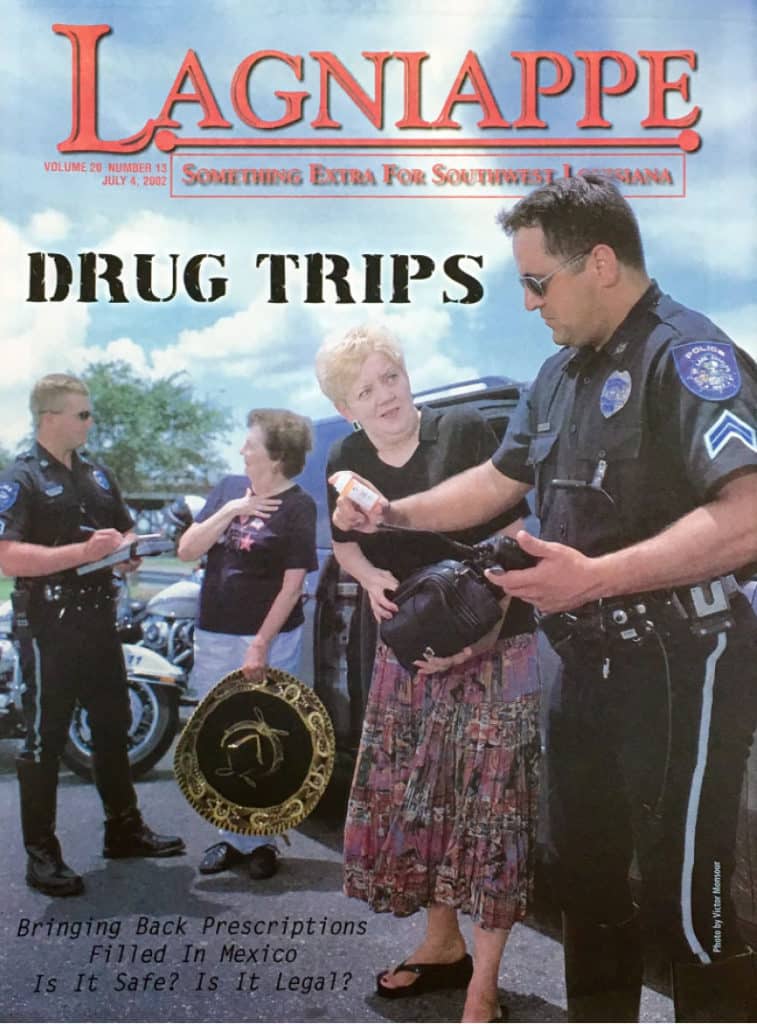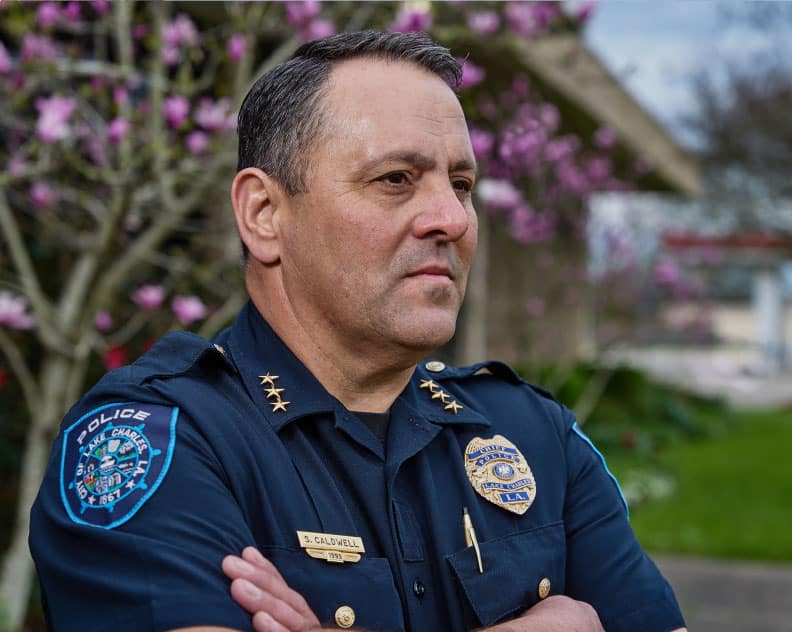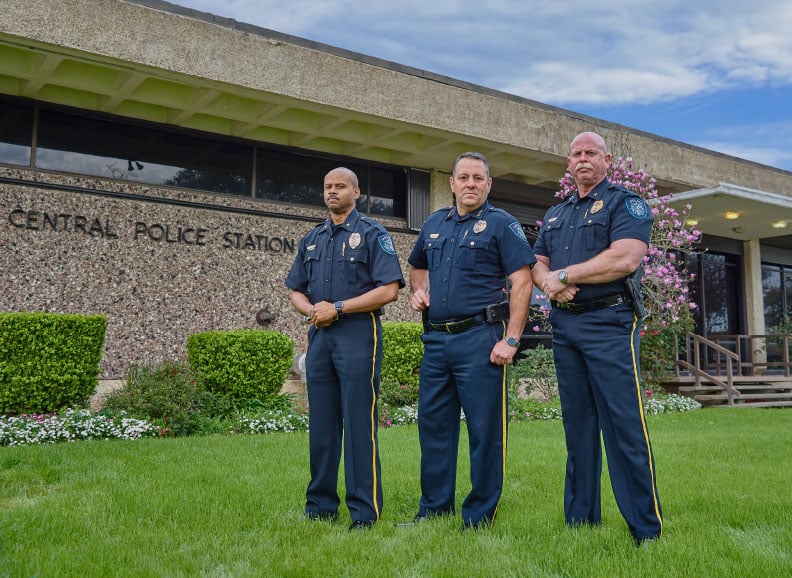New LCPD Chief Shawn Caldwell Has A Keen Focus On The Issues
Story By Brad Goins • Photos By Jason Carroll
When I talked with Lake Charles Chief of Police Shawn Caldwell in mid-February, he told me he was still “settling in” to his new job. His first month had largely been dedicated to working with two new deputy chiefs and quite a few others who had received promotions. All of this was part of an effort “to get all of our command staff in order.”

Deputy Chief Detective Sergeant Franklin Fondel, Chief of Police Shawn Caldwell and Deputy Chief Detective Sergeant Michael Nicosia. Photo By Jason Carroll
He’d also engaged with Mayor Nic Hunter in talks “about how we want the police department to move forward.” Thus far, he’s been quite pleased with Hunter’s positive attitude about the department and receptivity to its needs. “We’re a team,” says Caldwell.
“The transition went well,” he says. It’s clear he’s not far out of the transition. His office still looks almost sparse in terms of decoration.
Although Caldwell’s main activities so far have been devoted to administrative affairs and negotiations, he’s stayed focused on the areas that have been key concerns for law enforcement in the last few years.
Traffic
Chief among these may be traffic. “I am very proud,” says Caldwell, “of the way our local motorists have handled this issue. We’ve been fortunate.”
The pressures that the boom and the bridge work have exerted on traffic have “made us realize we’re going to have to deal with some commuting issues.” With the changes in traffic, area drivers have been forced to make the transition from small town drivers with short commutes to big town drivers with long commutes.
“We were not aware of how far the impacts would extend,” says Caldwell. “It took us a little bit to learn.” Drivers “have learned that it’s just going to take some time” to get to work and back. “The pipe isn’t big enough.”
With situations such as bridge work, local government agencies sometimes have very limited ability to resolve the problems that arise. Caldwell notes that the LCPD has begun working the I-10 and 210 corridors with extra officers. For the most part, though, Lake Area drivers will need to continue to adjust to a new situation and stay civil when the traffic piles up.
Gangs
If you’ve wondered why drug activity in the area isn’t more pronounced given Lake Charles’ location on an interstate roughly midway between Houston and New Orleans, Caldwell will tell you that there is plenty of drug, gang and related criminal activity around here. “Interstate 10 is the corridor of the South for unlawful conduct.”
He thinks that whatever criminal imports Lake Charles gets from the interstate are more likely to come from Houston than N.O. Criminals from Houston, he says, “come here and commit crimes,” and mentions a few high profile robberies of recent years.
Caldwell can’t say for certain that there are no members of Houston’s Latin Kings gang wandering around Lake Charles. But if they’re here, they haven’t made it onto the police’s radar. “To my knowledge, most of our gangs are territorial gangs that have little to no affiliation with national organizations … I’m using the term ‘gang’ loosely.”
In these “territorial” gangs, there is certainly none of the member-for-life mentality that prevails in major national gangs. The Lake Area’s territorial gangs are extremely cliquish. One argument can split a gang and start an entirely new gang. “They’re constantly changing,” says Caldwell.
None of this means that a member of a local territorial gang can’t do every bit as much damage as a full-fledged Houston Latin King. “They can be very dangerous,” says Caldwell. “They can be armed.” Local gang activity “is a significant contributor to crime,” and especially juvenile crime.
Drugs
In spite of its central location, the drug situation in Lake Charles is not radically different from that of other urban areas of the same size.
“Drugs are absolutely a problem here. I don’t see that changing any time in the near future,” says Caldwell.

SECOND COVER FOR CALDWELL
Chief Caldwell was on his first Lagniappe cover back on July 4, 2002. The cover story was on the large number of locals who were, at the time, traveling to Mexican border towns to pick up prescription drugs.
Caldwell, then a corporal, was joined on the cover (shot by Victor Monsour) by then-Corporal Billy Creel and local residents Connie McDaniel and Lou Thompson.
That being said, it’s not quite the Wild West just yet. “Marijuana is still very much [the drug] in this state. The opioid epidemic has somewhat made its way” into our area. “We’re seeing it.”
Caldwell says that local opioid abuse is especially problematic in its ability to cause fatalities. “It’s very, very scary in the amount of deaths that can be attributed to it.”
As for the relatively new phenomenon of vaping marijuana with such products as Juul, Caldwell says Lake Charles is “seeing some of that” — mainly among teenagers. “Right now it’s not a major problem.”
The origins of drug use and abuse among the young are pretty similar everywhere. Children may be drawn to drugs quickly if all the adults they’re around use drugs or if they have no adult role model who opposes drug use.
“People strive to meet the expectations of their loved ones … of those they deem their mentors,” says Caldwell. He thinks youthful involvement in drugs may also develop from “what social norms may [exist] in [the] community … in [the] immediate society” the youth lives in. Social norms could have some effect.
The LCPD complements the educational component of its drug-fighting efforts by carrying on activities in which police officers have positive interactions with at-risk youth. In one program, officers sit down with students and eat with them during the school lunch hour. Students get to know the officers and see them as potential friends rather than anonymous threats. In another program, police officers travel to local school libraries and read aloud to students.
Juvenile Crime
As for juvenile crime in general, “absolutely it is on the rise,” says Caldwell. He is especially concerned about “juveniles involved in violent and gun crimes.” That, he says, “is very much on the rise.
“We’re losing our greatest resources, which are our children.”
Under Caldwell, police will continue to meet with elected officials and church leaders in hopes of discovering new ways of rolling back juvenile crime. “It’s going to take public-private partnerships to find solutions,” says Caldwell.
An excellent tool the LCPD has for combatting juvenile crime is the MARC — or Multi-Agency Resource Center. The center, says Caldwell, is designed to “try to keep juveniles out of the criminal justice system.”
MARC staff can connect juveniles who’ve gotten in trouble with community services in a matter of hours. For juveniles who have been taken in on an allegation of criminal activity, MARC offers a secure intake area; this significantly reduces the amount of time such juveniles are in custody. Juveniles go through an assessment process designed to find alternatives that avoid detention and are positive for youth and their families.
MARC is extremely accessible, with hours running from Monday through Saturday 8 am until 2 am and Sunday 1 pm until 11 pm. It serves those who are 6 through 17.
Juveniles who would like to suggest activities or other options for youth to the mayor’s office can do so through the Mayor’s Youth Partnership at 491-8735.
Police Pay
Caldwell’s position on LCPD pay is abundantly clear. “Law enforcement pay here in general is absolutely low,” he says.
“Pay should be relative to the responsibilities of the group. We expect our people to strap on a gun [and face dangers daily]. Their responsibilities are vast; truly immense. To have to fight tooth and nail to get a fair wage is just a shame.”
Caldwell sees Mayor Hunter’s use of a pay matrix as a “first step” in fixing the problem. The pay matrix assures LCPD officers that as they rise through the ranks, they will be guaranteed at least a certain salary at each new rank. This will reduce the number of officers who feel that their advancement has gone unrewarded and are comparing the pay at their ranks to the pay of people in comparable positions in business.
“People who reach certain ranks know they’ll get a certain salary,” says Caldwell. “I applaud the mayor” for his work on the matrix that makes that outcome possible.
Caldwell notes that LCPD officers may leave the force to go to business, the state police or even the sheriff’s office, not just because of the pay rate, but also because these other employers may offer superior benefits. “My staff and the city administration must come up with a plan to increase pay benefits and the ability to advance in the police department … I believe the mayor is very open to sitting down and formulating a plan.”
But the work’s a long way from finished. Right now, Caldwell says he is “34 officers down.” What he means by that is that 22 officers are ready to take their posts but are still in training. And another 12 posts are vacant. That’s 34 officers who could be contributing but aren’t at present.
“Recruitment and retention are huge” for us, says Caldwell.
Steady As She Goes
Caldwell is calm and even-keeled. He speaks directly and precisely. He’s as careful about what he doesn’t want to say as what he does. There’s no hint of boastfulness in his speech.
He’s a local product, growing up in Lake Charles; graduating from LaGrange; attending McNeese. With wife Lorri, he’s raising a family that already includes three children: Jacob, Grant and Aubrey.
He first started working for the LCPD in 1993 as a patrol officer. After a year, he moved to the bicycle division, where he worked on community policing.
After a decade, and stints as a motorcycle officer and work in the traffic division, Caldwell found himself in the Office of Professional Standards, where he was both Recruitment and Selection Officer and Internal Affairs Investigator. After a brief tenure as a patrol officer, he returned to the office in 2010.
In 2013, his promotion to Deputy Chief in the Support Bureau put him in charge of the police fleet and communications. A move to Deputy Chief in the Operations Bureau two years later saw him overseeing all uniformed patrol offices, neighborhood police, K-9s and the jail.
Caldwell’s calm demeanor, as well as his experience in a wide variety of police work, are strong indicators that there’s a steady hand at the wheel.



















Comments are closed.